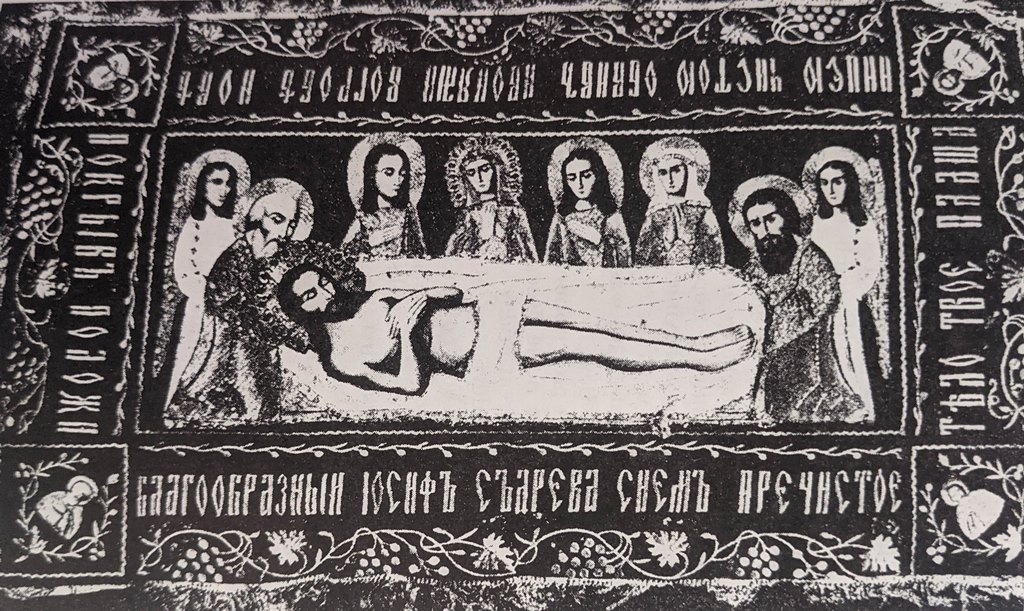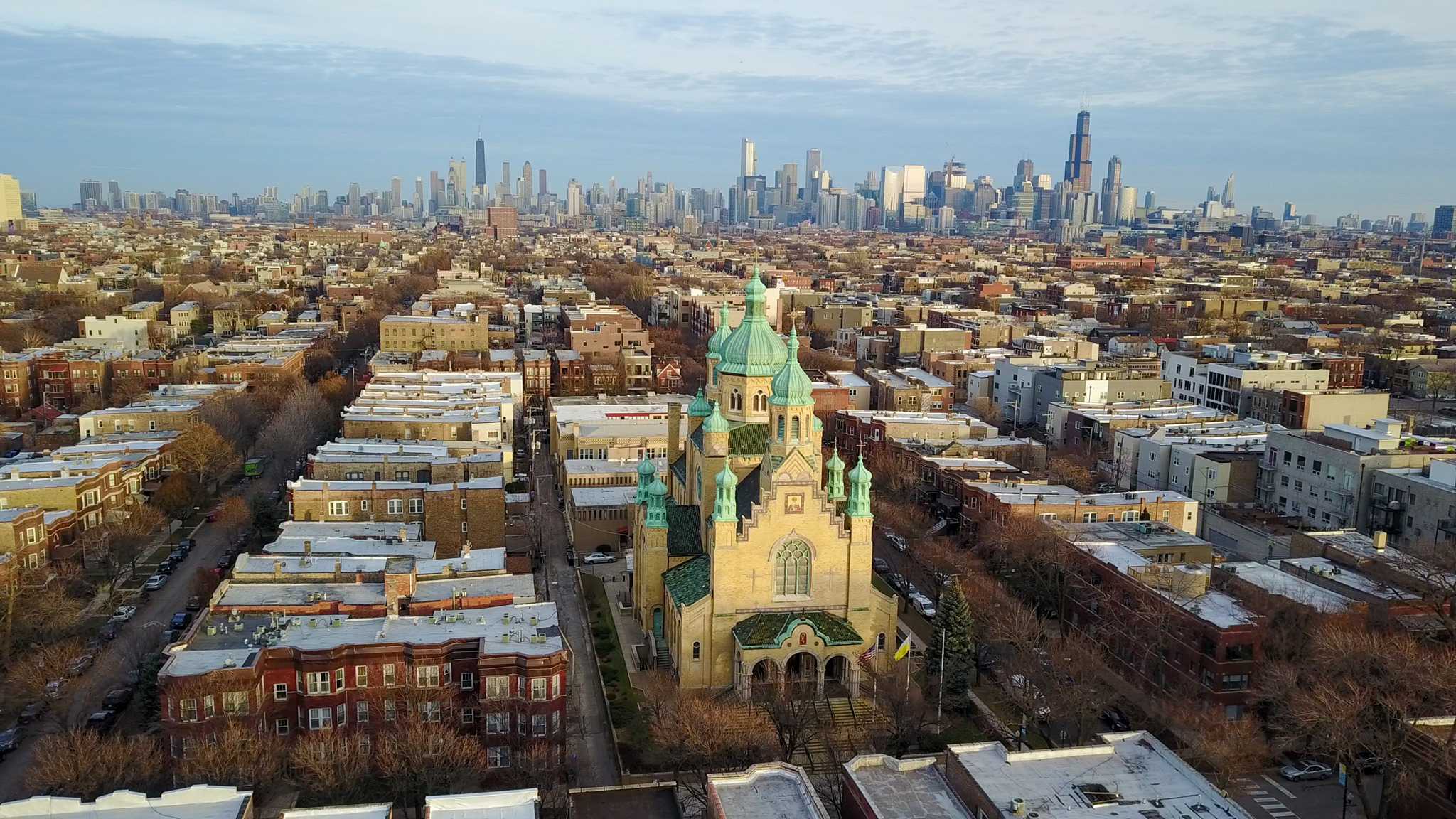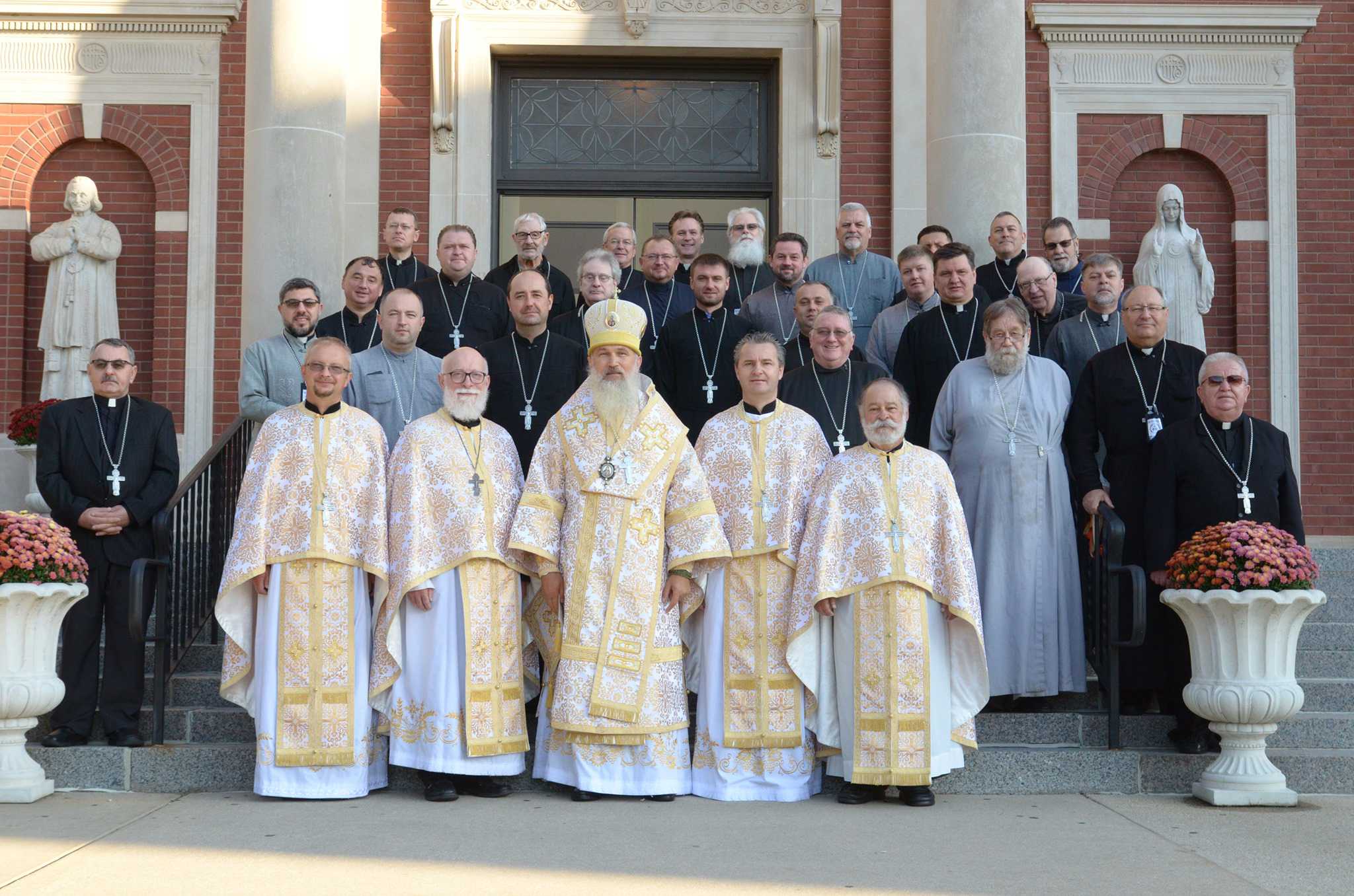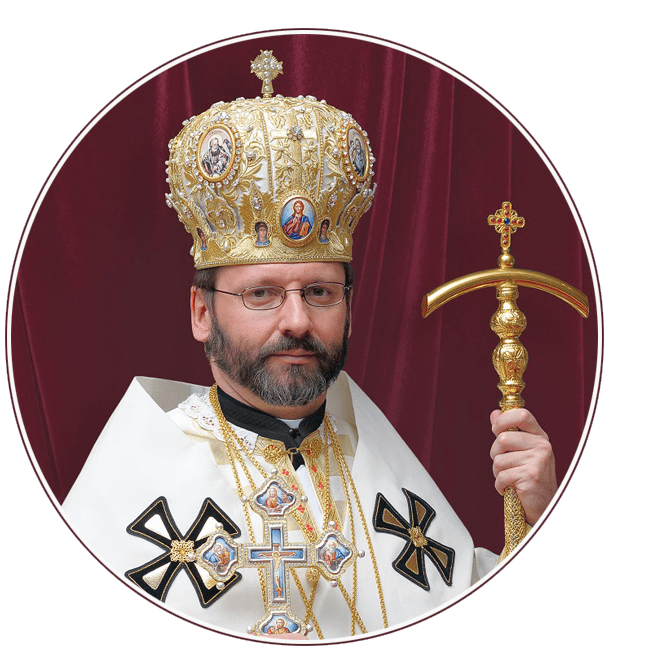"Noble Joseph took down Your most pure body from the tree,
wrapped it in a clean shroud,
covered it with spices and laid it in a new tomb. "
(Troparion of Holy or Great Friday)
The service of Great or Holy Friday is characterized by its very beautiful ceremonies, stirring hymns and melodies and sticheras of profound significance. Their main theme is the suffering and death of our Lord Jesus Christ.
In the fifteenth antiphon of the Matins service of Great Friday we sing: "Today He hangs on the cross, Who hung the earth upon waters. The King of the angels has a crown of thorns placed upon Him. He was clothed in mock purple. The One Who in the Jordan freed Adam, received a slap. The Bridegroom of the church was riveted to the cross) with nails. The Son of the Virgin was pierced with a lance. Christ, we worship Your passion. Christ, we worship Your passion. Christ, we worship Your passion. Make known to us Your glorious Resurrection as well."
The central focus of the sublime and moving rites of the Great Friday services is the Holy Shroud (Plaschanytsia). This holy icon of Christ in the tomb became an integral part of the rites of the Vesper services of Great Friday and the Matins ser vice of Great Saturday. During these services we pay special public honor and veneration to the Holy Shroud. The reason for this is that the history of the salvation of mankind is inscribed on the icon of the Holy Shroud in blood-red letters. The Holy Shroud speaks to us of the severe justices of God and His everlasting love and unfathomable mercy toward us sinners.
Because of the liturgical significance of the Holy Shroud, it is fitting that we say a little more about its history and the rite of placing or exposing it for public veneration
History of the Holy Shroud
The Holy Shroud, as it is used today in the Great Friday and Saturday services, is of comparatively recent date, for it is scarcely several hundreds of years old. Its origin dates back, however, to the time of Christ's death. The Holy Shroud is nothing but the winding sheet in which Christ's dead body was wrapped when it was laid in the tomb. The Holy Shroud, as it is used in the services of Great Friday and Saturday, was unknown to the Eastern Church for about fifteen hundred years
The Christians of the Church of Jerusalem in the first centuries on Great Friday, venerated the wood of the cross which was discovered at the beginning of the fourth century by St. Helena, mother of the Emperor Constantine. The rite of the veneration of the cross was recorded by the pilgrim Silvia of Acquitaine (4c). In her Diary of a Pilgrimage, we read that on Great Friday the bishop, attended by deacons, processed to Golgotha where he sat on a throne set up for him on the very spot where Christ was crucified. While the deacons stood around him, a table covered with a linen cloth was placed before him, and on this table was laid the sacred wood of the cross and its inscription. The bishop held the ends of the sacred wood with his hands while the faithful came forth, one by one, approached the table, made a profound bow to the ground, touched the cross and the inscription with their foreheads and eyes, then kissed the cross and departed.
The custom of venerating the Holy Cross on Great Friday later spread to the Greek Church. During the Matins service after the fifth Gospel of the Passion, while the above stichera, Today He hangs on the Cross..." was being sung, the priest or the bishop took the processional cross from behind the altar and carried it out of the sanctuary and placed it in the middle of the church. As the following words of the stichera were be ing sung "We worship Your passion, O Christ...", the priest and all the faithful made three bows to the ground and then kissed the Holy Cross
Under the influence of the Eastern Church the veneration of the Holy Cross on Great Friday in the middle of the seventh century reached to the Western Church where it is still practiced at the present day.
During the Divine Liturgy the Eastern Church covers the holy gifts on the proskomedia with a large rectangular veil. This veil, which is also called the "aer", began to be used in the Liturgy by the Church of Jerusalem during the time of St Sabbas the Sanctified (+532), author of the Jerusalem Typicon. St. Germanus, Patriarch of Constantinople (713-730), teaches that the "aer" is the symbol of that stone with which Joseph of Arimathea sealed the tomb of Christ According to Simeon of Thessalonica (†1429) however, the "aer" is interpreted as the symbol of the naked and dead body of Jesus, which was laid in the tomb. For this reason, he says the picture of Christ as He is being laid in the tomb, is sometimes depicted on the "aer". At the Great Entrance the deacon carries this "aer" before the holy gifts. The priest then takes it and covers the chalice and the bread on the altar with it, while reciting silently the troparion: The noble Joseph..." This Greek custom of having the veil on the icon of Christ in the tomb came to us in the fourteenth century along with the Jerusalem Typicon. This was the beginning of our Holy Shroud (Plaschanytsia).
According to the prescriptions of the Jerusalem Typicon the troparion, "The noble Joseph...", is sung also in the Vespers service of Great Friday and in the Matins service of Great Saturday. Our devout ancestors, it seems, when singing this requiem hymn in honor of the Saviour, not only wished to relive this event in spirit, but also wished to see with their own eyes the icon representing His being laid in the tomb. For this reason the veil, our first Shroud, because of its symbolic meaning, came after this troparion, at first in the Matins services of Great Saturday, then afterwards in the Vespers service of Great Friday.
In the sixteenth century there appears among our people the custom of carrying the "aer"-shroud with the icon of the dead Christ during the entrance with the Holy Gospel at the Great Doxology in the Matins service of entrance ends with the singing of the troparion "The noble eat Saturday. The Joseph...", and the veneration by bowing down and kissing the aer-shroud. After Matins it is again placed on the altar together with the Gospel Book. During this century, the vell with the icon of Christ in the tomb was first called by our people the "plaschanytsia" or shroud. The rite of venerating the Holy Shroud was, after some time, transferred from the Matins service of Great Saturday to the Vespers service of Great Friday. This happened, probably because the troparion "The noble Joseph..." was sung in the services of Passion Week for the first time in the Vespers service of Great Friday.
In addition to the figure of Christ in the tomb we now have the figures of Mary the Mother of Jesus, Joseph of Arimathea and the pious women who took part in the burial of Jesus Christ depicted on the Holy Shroud. Along the border of the shroud are inscribed the words of the troparion "The noble Joseph, etc."
The Rite of Placing or Laying Out of the Holy Shroud
Our handwritten Typicons up to the sixteenth century make no mention of the rite of placing or laying out the Holy Shroud, for it had just begun to come into practice at that time. Since the Holy Shroud became part of the Vespers service of Great Friday and Matins service of Great Saturday, not by virtue of a special prescription, but by way of a custom of the Church, there is no one uniform rite of placing the shroud to this day. In this regard various local Churches developed their own customs. The veneration of the Holy Shroud in the seventeenth-eighteenth centuries became a general universal practice and custom of the entire Eastern Church.
The rite of carrying out and the placing of the shroud according to the Typicon of Father Isidore Dolnytsky was performed at the cathedral churches in Galicia in the following manner:
"During the Vespers service of Great Friday, while the following stichera of the Aposticha was being sung, 'You who clothe yourself with light as with a garment...' a procession was made around the church with the shroud, which was carried by four priests or elders of the church, each holding one of the four corners. After the procession, the shroud was placed upon a specially prepared table in the middle of the church. At the end of the Vespers service while the troparion "The noble Joseph..." is being sung three times, all approached the Holy Shroud on their knees and devoutly kissed it. The Lord's grave was adorned with flowers and burning candles, and behind the grave stood a plain cross without the corpus (the crucified body of Christ) with a cloth hanging over its cross beams. "
Father I. Dolnytsky recalls also that in Galicia there was a custom during the procession with the Holy Shroud to carry the Sacrament of the Holy Eucharist, which afterwards was placed either on the top of the grave of the Lord or on the altar for adoration. He remarked that this custom had been taken over from the Latin Church. The custom of exposing the Blessed Sacrament in conjunction with the Shroud is completely contrary to the spirit of Great Friday and the spirit of the Eastern Church. The Holy Shroud, as a matter of fact is actually the symbol of Christ in the tomb; therefore, there is no reason here for the public veneration of the Blessed Sacrament. On Great Friday in some localities in the Western Church, the Blessed Sacrament is removed from the tabernacle and the tabernacle doors are opened to indicate that Christ is not present there, but in the tomb.
The Typicon of Dr. Alexander Mykyta says that in Carpatho-Ukraine, during the procession with the shroud, the priest carries the shroud on his back holding one end of the Shroud on his head, while the other end is held by two people. The procession is made only once.
In Eastern Ukraine and Russia during the Vespers while the troparion "The noble Joseph" is being sung, the Holy Shroud is carried out only to the middle of the church; whereas the procession with the Holy Shroud takes place at the Great Doxology in the Matins service of Great Saturday. During the procession the priest carries the shroud upon his head and under the shroud he also holds the Gospel Book which he later places on the Holy Shroud at the Lord's grave.
The Holy Shroud remains exposed for veneration until the Matins of the Resurrection. Before Matins, following a short service performed at the grave, it is carried into the sanctuary and placed on the altar. There is no special prescription as to where the Holy Shroud should be placed during the Easter season. Some churches keep on the altar until St. Thomas Sunday, then hang it up on the wall behind the altar above the cathedra (or throne), while in other churches the shroud remains on the altar until the Sunday of the Myrrh-bearing Women. In our churches the shroud remains on the altar until the Feast of Ascension, i.e. forty days, as a sign of Christ's sojourn of forty days on earth.
Among our people, the Holy Shroud is truly venerated and loved. Many of our faithful observe a strict fast on the Great Fri day and approach the Holy Shroud fasting, just as they would approach to receive Holy Communion. They approach the Holy Shroud in no other way than on the knees, starting frequently as far back as the doors of the church. By the grave of our Lord, sometimes through the whole night from Great Fri day to Saturday, an honor guard usually stands provided by our youth and adult organizations. The veneration and the kissing of the Holy Shroud is, for our faithful, a truly profound spiritual experience and an opportunity to renew their faith and love for Christ, who out of love for us, died on the Cross.
The Funeral Stichera Sung During the Rite of Placing the Shroud
"You, who clothe Yourself with light as with a garment, were taken down from the cross by Joseph and Nicodemus. And seeing You dead, naked and unburied, he raised a heart-rending lament and said: 'Alas, dearest Jesus! A short while ago the sun saw You hanging on the cross and covered itself with darkness. The earth trembled in fear, and the veil of the temple was torn asunder. But now I see You who, willingly, underwent death for my sake. How can I bury You, my God? In what kind of shroud can I wrap You? With what kind of hands can I touch Your incorruptible Body? What song shall I sing at Your departure, merciful Lord? I extol Your Passion, and with hymns I praise Your burial together with Your Resurrection, crying out: 'O Lord, glory be to You!"
Source: A Byzantine Rite, Julian J. Katrij, OSBM

 Eparchy
Eparchy  Clergy
Clergy  Cathedral Church
Cathedral Church  Parishes
Parishes  Mission Institute
Mission Institute  The capital campaign
The capital campaign 
